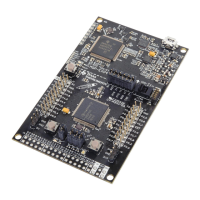7.4.8 Set Memory Offset
7.4.9 Load PC
7.4.10 TX Data Block
7.4.11 TX BSL Version
Data Frame
An offset for the memory pointer can be set for devices that have more than 64K of memory, specifically
MSP430X architecture devices. The value for the memory offset is used as the memory pointer’s upper
word.
MemoryAddress = OffsetValue << 16 + ActualAddress
Note: This command is implemented on BSL versions V2.12 and greater.
The load program counter command directs the program counter (register R0) to any location within the
entire address range. It is password protected.
After receiving the data frame, an acknowledge character (DATA_ACK) is sent back by the BSL. Then the
selected address is moved into the program counter. The program flow continues operation there, and the
BSL session is terminated.
Be aware that the password protection is not active at this time.
The transmit data block command is used for any read access to the flash memory/RAM or peripheral
module control registers at 0000h–01FFh. It is password protected.
The 16-bit block start address is defined in AL (low byte) and AH (high byte). The 16-bit block length is
defined in LL (low byte) and LH (high byte). Because pure data bytes are limited to a maximum of 250, LH
is always 0. The checksum bytes CKL (low byte) and CKH (high byte) immediately follow this information.
Now the BSL responds with the requested data block. After transmitting HDR, dummy CMD, L1 and L2,
The BSL sends data bytes D1 through Dn, followed by the checksum bytes CKL (low byte) and CKH (high
byte). No acknowledge character is necessary.
The transmit BSL version command gives the user information about chip identification and bootstrap
loader software version. It is not password protected.
The values for AL, AH, LL, and LH can be any data, but must be transmitted to meet the protocol
requirements. The checksum bytes CKL (low byte) and CKH (high byte) immediately follow this
information.
After that, the BSL responds with a 16-byte data block. After transmitting HDR, dummy CMD, L1 and L2,
the BSL sends data bytes D1 through D16 (decimal), followed by the checksum bytes CKL (low byte) and
CKH (high byte). No acknowledge character is necessary.
D1, D2 and D11, D12 (decimal) hold the specific information:
• D1: Device family type (high byte)
• D2: Device family type (low byte)
• D11: BSL version (high byte)
• D12: BSL version (low byte) The remaining 12 bytes are for internal use only.
SLAA089D – December 1999 – Revised August 2006 Features of the MSP430 Bootstrap Loader 11
Submit Documentation Feedback

